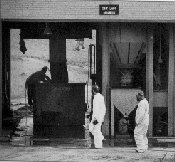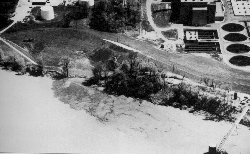On March 17, 1977, employees at the Morris Forman plant noticed a strong, chemical odor that made them sick. It was the beginning of an environmental incident that would set legal precedent in the United States.
It took more than a week to identify the substance: a mixture of hexachloropentadiene and octachlorocyclopentene, quickly abbreviated to "hexa" and "octa." They were highly toxic chemicals used in pesticides. The contaminated treatment plant was shut down on March 29th, discharging 100 million gallons of untreated wastewater into the river each day.
The U.S. Army sent teams wearing protective gear into the sewers to find the source of the chemicals. The FBI joined the investigation. And on June 7th, a federal grand jury charged Donald E. Distler, president of Kentucky Liquid Recycling, and two of his employees with dumping toxic chemicals into the sewers.
The chemicals, the courts later found, were wastes that had been sent to Distler’s company for disposal. Distler’s company had dumped them down a manhole in western Louisville.
The treatment plant was shut down for nearly three months while the contaminated material was removed — three months of discharging all the raw sewage into the river. It took another two years to remove the contaminated material from the sewer lines — years during which the raw sewage from these lines was shunted around the plant and into the river.

Courier-Journal and Louisville Times Photo by Paul Schuhmann
In September, 1979, the month the cleanup ended, Distler was found guilty — the first time an individual was convicted in a trial of federal criminal charges of polluting a waterway. He was sentenced to two years in prison and fined $50,000. After appealing all the way to the U.S. Supreme Court, he was sent to prison in early 1982.
And in January, 1983, the companies that had originated the waste — Velsicol Chemical Corp. of Chicago and Chem-Dyne Corp. of Hamilton, Ohio — agreed to pay MSD $1.9 million for the medical costs of employees and the costs of cleaning up the sewers and the treatment plant.

Courier-Journal and Louisville Times
Photo by Dan Dry

Courier-Journal and Louisville Times Photo by Billy Davis III
The Sewer Explosions
Shortly after 5:15 a.m. on Friday, February 13, 1981, two women going to work at a hospital drove under the railroad overpass on Hill Street near 12th Street. There was a gigantic blast, and their car was hurled into the air and onto its side.
At the same time, a police helicopter was heading toward the downtown area when the officers saw an unforgettable sight: a series of explosions, "like a bombing run," erupting along the streets of Old Louisville and through the University of Louisville campus.
MSD History continued - The Southwestern Louisville Flood


